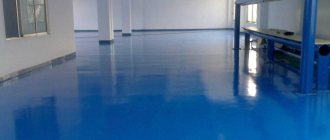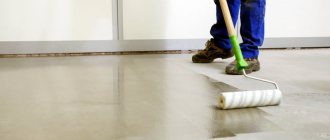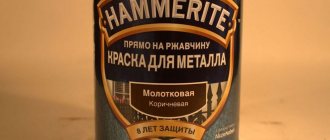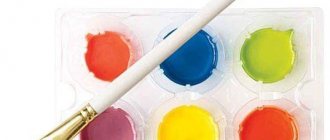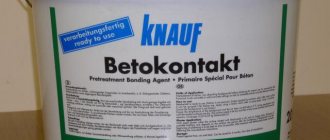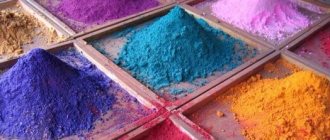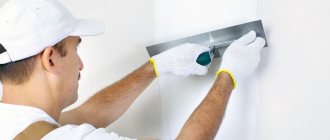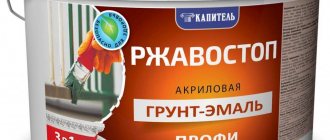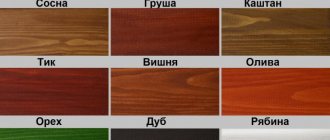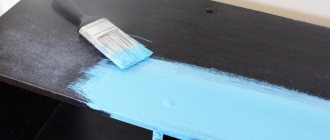Hello.
Please explain what rubber concrete paint is. I’m very interested in whether it can be used for temporary finishing of floors and walls in bathrooms and the floor on an unglazed balcony? How long will it last, will it protect the concrete from moisture and mold? How to apply it correctly? I would like to more or less tidy up the apartment I bought with a mortgage in a rough finish. The walls and floors are quite smooth, there is no money for tiles yet, but I want to move in as soon as possible. I would be grateful for your advice.Oleg.
Balcony floor painted with rubber compound
Good afternoon, Oleg. You have made a very right choice: rubber paint for concrete is perfect.
Rubber paint for concrete - what is it?
Protective and finishing paint for concrete based on acrylate latex is available in tin or plastic cans, in the form of an aerosol.
It is used for interior and exterior painting of floors, paths, walls, balconies, bathrooms, basements, pillars, fences. It is also used to cover rubber concrete on sports and playgrounds. The painted surface is pleasant, smooth to the touch, and does not slip.
After drying, the enamel has good elasticity and flexibility. Its components ensure compression of the coating when the air temperature decreases and its expansion when it increases. At the same time, the protective layer does not crack, does not deform, and does not lag behind the cement.
Rubberized paint for concrete is resistant to low (up to -80 ℃) and high (up to + 80 ℃) temperatures. Therefore, it is convenient to use it for outdoor work in cold or hot climates, as well as during sudden temperature fluctuations.
Enamel creates a waterproof layer on the cement surface. Like rubber, it prevents water from penetrating into its pores, protecting it from gradual destruction.
In addition, enamel components prevent the formation of dampness, moss, and fungus. Therefore, it is used for treating facade walls, foundations, ramps, bathrooms, basements and rooms with high humidity.
It has high wear resistance. The service life of the paint and varnish coating is 10 years. Expensive enamels last up to 30 years without deteriorating performance characteristics. They are used for running and cycling paths on the street, for road markings, on courts, stadiums, and in gyms.
Latex enamel is suitable for processing not only concrete surfaces, but also brick, plaster, cement plaster (but not coated with slaked lime), putty, drywall, chipboard, fiberboard. The painted surface has a beautiful color, gloss, resistance to harmful external factors, and wear resistance.
The technical characteristics of rubber paint for concrete are specified by the manufacturer on the packaging and depend on its composition. The averages are:
- weight of 1 liter – 1.1 kg;
- complete drying time – 12 hours;
- operating temperature limits – from – 80 ℃ to + 80 ℃;
- coating elongation – 350-400%;
- does not spontaneously ignite;
- without smell;
- service life – 10 years.
Note! In stores you can find paints with operating temperature thresholds from - 100 ℃ to + 200 ℃.
A variety of colors of latex paints will satisfy the most demanding tastes.
Painting process
Preparing for coloring
This step is very important if you really want to test the full strength of the paint, and cannot be ignored.
Surface cleaning
Your goal is to achieve as smooth and non-porous a cleaned surface as possible.
- Using a metal brush, grout mesh, spatula or sandpaper, thoroughly clean the surface from dust, dirt, moss and traces of old processing. Pay special attention to traces of slaked lime whitewash, as well as residues of oil-based paints and alkyd paints - these should be removed down to the putty or plaster.
Grease and oil stains should be rubbed until they completely disappear. If the grease is eaten too deeply, then the wall should be moistened with dishwashing detergent for a couple of hours, and from time to time wetting it again to ensure that the stains are washed off.- Glossy parts of fiberboard, MDF and other structures should be thoroughly sanded to a matte shine.
- If there are cracks, you should definitely fill them up, and when everything is dry, sand them.
- Clean all metal surfaces from dirt, traces of old paint and dust using a metal brush, and then sand and degrease with a solvent, for example, white alcohol. If there is a gloss, it is advisable to make the surface matte so that the adhesion to the paint is as good as possible.
- After all cleaning, puttying, sanding and sanding work has been completed, the surface should be freed from dust residues and then washed with an alkaline solution. After half an hour, rinse the surface again, but this time with clean water and leave until completely dry.
Now you can move on to the second step, namely the priming work.
Padding
Before starting the process, metal elements should be coated with an anti-corrosion compound, and then insulated or coated with an inhibitory primer. You will also need to use a special primer with anti-corrosion properties like GF-021.
Important! If after priming the surface remains glossy, then you should sand it a little to a matte shade.
- Cement, concrete, asbestos-cement and other surfaces with a porous structure should be coated at least twice with an antiseptic or deep-penetrating facade primer.
- Coat the wooden parts with acrylic-silicone primer.
- For all other surfaces, a universal primer based on latex or acrylic is suitable.
- If the prepared surfaces are subject to regular negative environmental influences (snow, rain, etc.), then an additional hydrophobic primer coating can be used.
Helpful advice: if you apply the primer in 2 or more layers, then first you should let the first layer dry, and then apply the next one.
Coloring
To paint a concrete garage floor with rubber paint, you will need the following tools: a paint brush, foam rollers or polyamed-type faux fur, and a spray gun.
Optimal temperature and weather conditions for painting:
- Air temperature from +5 to +27 degrees.
- There is no precipitation or bright sun, relative humidity should be no more than 70%.
- Do not apply paint in strong winds that carry dust.
Important! You can dilute the paint with water, but only for applying the first layer and no more than 1/10 of the total volume.
Process Features
- Apply several thin layers rather than one thick one. The interval between applying each layer should be at least two hours (or better yet, 4 hours).
- Stir the paint regularly to ensure an even coating on the surface.
- The paint should be distributed over the entire surface to be painted and get into all, even the smallest cracks and gouges. This is difficult to achieve with rollers, particularly in hard-to-reach places and corners, so all imperfections should be painted over with a brush.
- During breaks when applying layers, you should not leave tools in the open space, as paint residues will quickly begin to harden, and then it will be extremely difficult to wash them.
Please note that you can wash painted surfaces no less than 7 days after painting has been completed, since during this period the coating will completely harden and acquire its wear-resistant properties.
Features of application for outdoor work
Rubber paint for concrete is used in home and industrial construction, repair of buildings and structures. Main areas of its application:
- Facades of residential buildings, industrial buildings, reinforced concrete fences. Thanks to rubber paint, the walls of the building acquire a pleasant color, are moisture and frost resistant, and are not covered with moss, fungi, or dirt. Re-painting of the walls will be required no earlier than 7-8 years after treatment.
- Stationary cast pools. The latex coating will provide waterproofing, a beautiful azure or blue color of its walls and bottom, and a safe descent and exit from the pool for swimmers. You can choose the paint color at your discretion. The moisture-resistant latex layer does not slip. This is especially true for families with children.
- Bicycles, jogging tracks, sports grounds, courts. Rubber floor paint for concrete provides good adhesion of the athlete's shoes to the floor covering on which he is training. This eliminates injuries and falls from slipping sneakers during sports.
- Roofing made of natural tiles, slate, ondulin. Despite the fact that the manufacturer indicates “for concrete” on the packaging, builders successfully use it to protect house roofs from moisture, fungus, and dirt.
Latex paint for concrete is a multifunctional protective and decorative coating.
Preparatory activities
Paint and varnish coatings must be applied exclusively to the prepared substrate. The surface should be as free from dust and debris as possible. Even otherwise, a high degree of adhesion with the base will not help. When tapping concrete, you can find weak spots that must be eliminated. To do this, a major or partial repair of the surface is carried out. If there are areas covered with old paint, it should be cleaned off. It would be a good idea to treat protected areas of concrete with a primer. It will help strengthen the base and also “bind” dust. Sanding and painting a concrete floor doesn't take much time, but it does require close attention.
Very often, before applying paint to the surface, water is added to it. But experts are categorically against such actions. It is enough to stir it thoroughly.
If the work is carried out in one room, then a construction roller will be sufficient. In other cases, most often a spray gun is used to reduce the time required to complete the work. There are also requirements for temperature conditions. During application it should not fall below +5 degrees.
What is included, main components
The composition of rubber paint on concrete determines its characteristics and performance properties:
- Acrylate latex (up to 15%) – provides elasticity and ease of application.
- Coalescent is an organic solvent responsible for reliable adhesion to concrete, protection from ultraviolet radiation, moisture, and mechanical factors.
- Antifreeze is an additive that is resistant to temperature fluctuations and high and low temperatures.
- Antifungal additive – protects against dampness, mold, and moss.
- The coloring component is an inorganic pigment that is resistant to fading and imparts color to the coating.
- Water (no more than 7%) serves as a solvent.
All these components are fire resistant. They are environmentally friendly and do not cause allergies.
Properties
Rubber paint for concrete floors is popular and widely used due to the large number of properties and qualities, among which the most basic can be identified:
- Wear resistance. It can last for a long time.
- Shockproof, waterproof, anti-slip.
- Ecological cleanliness.
- Lack of odor, both during application and after complete drying.
- Does not contain organic solvents.
This type of concrete floor covering is also used to remove dust from the base. By maintaining the same room temperature at 20 degrees, the paint can dry in less than one hour. You can choose a variety of colors that will fit into any interior of the room.
During operation, polymer paint protects the base of the concrete floor from mechanical and other external damage and transport loads.
Technology of applying paint to a concrete surface
- Thorough cleaning of the base: removal of grease stains, dirt, and remnants of old coating. In this case, the coating with oil or alkyd paint, as well as whitewash, is completely removed;
- Washing the base with sodium phosphate solution or water;
- Careful sealing of cracks, cavities, removal of material deposits;
- Light grinding followed by dust removal of the surface;
- Primer with deep penetration composition. Metal elements are painted separately, and porous or cellular concrete is primed with at least two layers;
- Thoroughly dry the base;
- Applying the first thin layer of rubber paint in any convenient way;
- Drying;
- Apply the second and third coats at an interval of 2-3 hours between applications.
Where can it be used and who produces it?
See also
Project of a house with a basement and attic: what is the ideal option
It is also important to remember that rubber paint is universal.
But still, the list of surfaces on which the composition can be applied is limited.
This includes the following coatings:
- concrete;
- brick;
- metal;
- glass;
- fake diamond;
- a natural stone.
All other surfaces cannot be coated with latex paint. Or they won't hold up well. Therefore, you will waste your money on an expensive paint and varnish composition.
Among the leading manufacturers are the following brands:
- Tikkurila;
- Farbex;
- Dali;
- Mastergood;
- Super Decor Rubber;
- Rezulux;
- Akterm.
If you know any other quality brands, please leave reviews.
